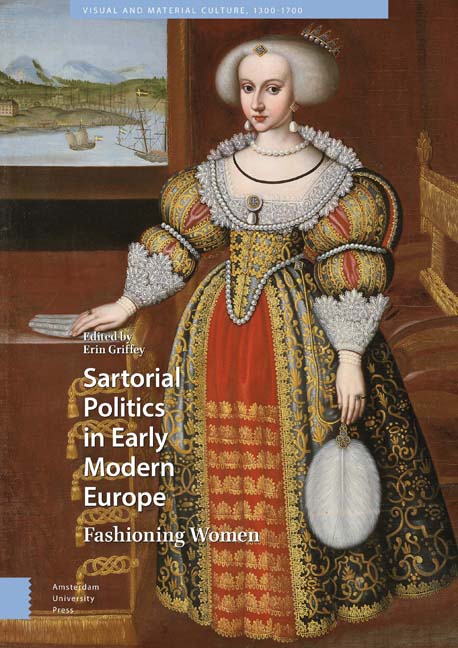Book contents
- Frontmatter
- Acknowledgements
- Contents
- List of Illustrations
- Introduction
- 1 Isabella d’Este's Sartorial Politics
- 2 Dressing the Queen at the French Renaissance Court: Sartorial Politics
- 3 Dressing the Bride: Weddings and Fashion Practices at German Princely Courts in the Fifteenth and Sixteenth Centuries
- 4 Lustrous Virtue: Eleanor of Austria's Jewels and Gems as Composite Cultural Identity and Affective Maternal Agency
- 5 Queen Elizabeth: Studded with Costly Jewels
- 6 A ‘Cipher of A and C set on the one Syde with diamonds’: Anna of Denmark's Jewellery and the Politics of Dynastic Display
- 7 ‘She bears a duke's revenues on her back’: Fashioning Shakespeare's Women at Court
- 8 How to Dress a Female King: Manifestations of Gender and Power in the Wardrobe of Christina of Sweden
- 9 Clothes Make the Queen: Mariana of Austria's Style of Dress, from Archduchess to Queen Consort (1634–1665)
- 10 ‘The best of Queens, the most obedient wife’: Fashioning a Place for Catherine of Braganza as Consort to Charles II
- 11 Chintz, China, and Chocolate: The Politics of Fashion at Charles II's Court
- 12 Henrietta Maria and the Politics of Widows’ Dress at the Stuart Court
- Works Cited
- Index
12 - Henrietta Maria and the Politics of Widows’ Dress at the Stuart Court
Published online by Cambridge University Press: 21 November 2020
- Frontmatter
- Acknowledgements
- Contents
- List of Illustrations
- Introduction
- 1 Isabella d’Este's Sartorial Politics
- 2 Dressing the Queen at the French Renaissance Court: Sartorial Politics
- 3 Dressing the Bride: Weddings and Fashion Practices at German Princely Courts in the Fifteenth and Sixteenth Centuries
- 4 Lustrous Virtue: Eleanor of Austria's Jewels and Gems as Composite Cultural Identity and Affective Maternal Agency
- 5 Queen Elizabeth: Studded with Costly Jewels
- 6 A ‘Cipher of A and C set on the one Syde with diamonds’: Anna of Denmark's Jewellery and the Politics of Dynastic Display
- 7 ‘She bears a duke's revenues on her back’: Fashioning Shakespeare's Women at Court
- 8 How to Dress a Female King: Manifestations of Gender and Power in the Wardrobe of Christina of Sweden
- 9 Clothes Make the Queen: Mariana of Austria's Style of Dress, from Archduchess to Queen Consort (1634–1665)
- 10 ‘The best of Queens, the most obedient wife’: Fashioning a Place for Catherine of Braganza as Consort to Charles II
- 11 Chintz, China, and Chocolate: The Politics of Fashion at Charles II's Court
- 12 Henrietta Maria and the Politics of Widows’ Dress at the Stuart Court
- Works Cited
- Index
Summary
Abstract
Mourning dress was one of the most pervasive sartorial symbols at the early modern court. This essay examines Henrietta Maria's adoption of such dress after the execution of Charles I and the political agendas and social ideals that informed it. Analysing portraits of the queen in mourning, this chapter argues that these works were carefully calibrated to showcase her virtuous character and piety while also functioning as public reminders of her husband's ‘martyrdom’ and her son's claims to the throne. As such, her representation as a widow was tailored both to the expected social and visual conventions of dress and comportment for royal widows, but also as a part of a strategic campaign for the restoration of the Stuart dynasty.
Key words: Henrietta Maria; Charles I; Stuart court; widows; dress; history of emotions
Introduction
Death was omnipresent at the early modern court. The threats were all too visible – the constant dangers of disease, plague, and war meted out mercilessly to the young and old, the most powerful and most lowly. However, despite death's impartiality, there were high stakes at play in royal deaths. Royal death was both political and personal, portending the loss or weakening of a dynasty and the renegotiation of power at court as well as the emotional loss of a loved one. Dying and dead kings and queens remained at court as they had in life, attended by elaborate rituals, their embalmed bodies displayed in state to be glorified and mourned, and then buried with due respect and pomp.
This tableaux – the highly visual, material performance of the monarch's dead body and legacy – was carefully presented and observed by mourners. The optics and materials of mourning were carefully mapped out – the number of mourners, the huge outlay for mourning cloth, the measured display of emotion, and the retirement of the family of the deceased from everyday activities. With royal mourning, the affective was very much linked to the political. Mourning rituals and materials offered the opportunity to assert bonds of kinship and continuity with the deceased king while also showcasing the king's widow and heirs’ ongoing political relevance. For direct male heirs to the throne whose succession was secured, such staging of dynasty was relatively straightforward: they were presented as mourning the loss but seamlessly fulfilling the role destined for them.
- Type
- Chapter
- Information
- Sartorial Politics in Early Modern EuropeFashioning Women, pp. 277 - 302Publisher: Amsterdam University PressPrint publication year: 2019



